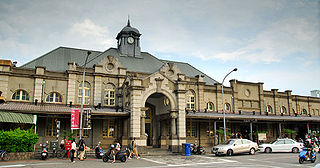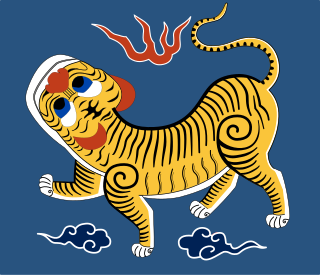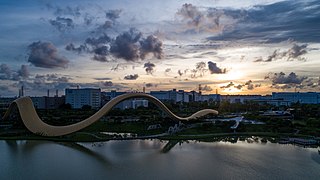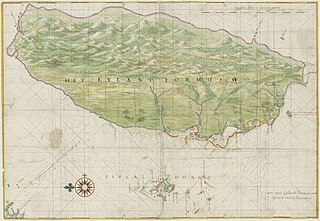Related Research Articles

Taiwan Province is a nominal administrative division of the Republic of China (ROC). Its definition has remained part of the Constitution of the Republic of China, but the province is no longer considered to have any administrative function practically.

The Republic of Formosa was a short-lived republic that existed on the island of Taiwan in 1895 between the formal cession of Taiwan by the Qing dynasty of China to the Empire of Japan by the Treaty of Shimonoseki and its being taken over by Japanese troops. The Republic was proclaimed on 23 May 1895 and extinguished on 21 October, when the Republican capital Tainan was taken over by the Japanese. Though sometimes claimed as the first Asian republic to have been proclaimed, it was predated by the Lanfang Republic in Borneo, established in 1777, as well as by the Republic of Ezo in Japan, established in 1869.

Keelung or Jilong, officially known as Keelung City, is a major port city situated in the northeastern part of Taiwan. The city is a part of the Taipei–Keelung metropolitan area, along with the neibouring New Taipei city and Taipei. Nicknamed the Rainy Port for its frequent rain and maritime role, the city is Taiwan's second largest seaport . The city was founded by the Spanish Empire in 1626, called La Santisima Trinidad.

Lukang, formerly romanized as Lugang and also known by other names, is an urban township in northwestern Changhua County, Taiwan. The township is on the west coast of Taiwan, facing the Taiwan Strait. Lukang was an important sea port in the 18th century and 19th century. It was the most populous city in central Taiwan until the early 20th century. In March 2012, it was named one of the Top 10 Small Tourist Towns by the Tourism Bureau of Taiwan.

Sinshih District, alternatively spelled Xinshi, is a rural district in central Tainan, Taiwan, about 11 km north of Fort Provintia. As Sincan, it was one of the most important stations of the Dutch East India Company (VOC) in the 17th century. Missionary work formally began and the largest amount of inland trade occurred at Sinkan.

Anping District is a district of Tainan, Taiwan. In March 2012, it was named one of the Top 10 Small Tourist Towns by the Tourism Bureau of Taiwan. It is home to 67,263 people.

Fort Provintia or Providentia, also known as Chihkan Tower, was a Dutch outpost on Formosa at a site now located in West Central District, Tainan, Taiwan. It was built in 1653 during the Dutch colonization of Taiwan. The Dutch, intending to strengthen their standing, sited the fort at Sakam, about 2 miles (3.2 km) due east from modern-day Anping. During the Siege of Fort Zeelandia (1662), the fort was surrendered to Koxinga, but was later destroyed by an earthquake in the 19th century. It was rebuilt as Chihkan Tower afterwards.

Thomas Barclay was a missionary of the Presbyterian Church of England to Formosa from 1875 until his death. His ministry in southern Taiwan has been compared to the work done in northern Taiwan by George Leslie Mackay. He founded Tainan Theological College and Seminary in 1876.

The Japanese invasion of Taiwan was a conflict between the Empire of Japan and the armed forces of the short-lived Republic of Formosa following the Qing dynasty's cession of Taiwan to Japan in April 1895 at the end of the First Sino-Japanese War. The Japanese sought to take control of their new possession, while the Republican forces fought to resist Japanese occupation. The Japanese landed near Keelung on the northern coast of Taiwan on 29 May 1895, and in a five-month campaign swept southwards to Tainan. Although their advance was slowed by guerrilla activity, the Japanese defeated the Formosan forces whenever they attempted to make a stand. The Japanese victory at Baguashan on 27 August, the largest battle ever fought on Taiwanese soil, doomed the Formosan resistance to an early defeat. The fall of Tainan on 21 October ended organised resistance to Japanese occupation, and inaugurated five decades of Japanese rule in Taiwan.

Taiwan under Qing rule refers to the rule of the Qing dynasty over Formosa (Taiwan) from 1683 to 1895. The Qing court sent an army led by general Shi Lang and annexed Taiwan from the Ming loyalist Kingdom of Tungning in 1683. It was governed as Taiwan Prefecture of the Fokien (Fujian) Province until the establishment of the Fokien–Taiwan Province in 1887. There were more than a hundred rebellions during the Qing period, and actual Qing authority only extended to the coastal areas. The frequency of rebellions, riots, and civil strife in Qing-ruled Taiwan led to this period being referred to by historians as "every three years an uprising, every five years a rebellion." Qing rule over Taiwan ended when the island was ceded to Japan by the Treaty of Shimonoseki in 1895, following the Qing dynasty's defeat in the First Sino-Japanese War.

The recorded history of Taipei began with the Han Chinese settling of the Taipei Basin in 1709, leading up to the formation of the national capital of Taiwan and high-tech industry hub and that is now Taipei City. Other notable dates include the 1895 annexation of Taiwan by Japan, during which Taipei began to grow more rapidly, and in the 1950s, the USA's provision of financial assistance to the Republic of China government, after which the city continued on a path of fast structural and industrial growth.
The Capitulation of Tainan, on 21 October 1895, was the last act in the Japanese invasion of Taiwan. The capitulation ended the brief existence of the Republic of Formosa and inaugurated the era of Japanese colonial rule in Taiwan.

William Campbell (1841–1921) was a Scottish Presbyterian missionary to Formosa. He wrote extensively on topics related to Taiwan and was also responsible for founding the island's first school for the blind. Interested in the early history of the island, his knowledge of the time was such that he was called "without doubt the greatest authority on this subject living". He was probably the first European to see Sun-Moon Lake, which he named Lake Candidius in honour of the seventeenth century Dutch missionary George Candidius.

The Taiwan Church News is a publication of the Presbyterian Church in Taiwan. It was first published in 1885 as the Tâi-oân-hú-siâⁿ Kàu-hōe-pò under the direction of missionary Thomas Barclay, and was Taiwan's first printed newspaper. This early edition was also notable for being printed in romanised Taiwanese using the Pe̍h-ōe-jī orthography. The publication was banned during the latter stages of Japanese rule and editions were also impounded on several occasions during the martial law era in post-war Taiwan for discussing forbidden subjects.

Tainan, officially Tainan City, is a special municipality in southern Taiwan facing the Taiwan Strait on its western coast. Tainan is the oldest city on the island and also commonly known as the "Capital City" for its over 200 years of history as the capital of Taiwan under Koxinga and later Qing rule. Tainan's complex history of comebacks, redefinitions and renewals inspired its popular nickname "the Phoenix City". Tainan is classified as a "Sufficiency" level global city by the Globalization and World Cities Research Network.

The Formosa Expedition, or the Taiwan Expedition of 1867, was a punitive expedition launched by the United States against the Paiwan, an indigenous Taiwanese tribe. The expedition was undertaken in retaliation for the Rover incident, in which the Rover, an American bark, was wrecked and its crew massacred by Paiwan warriors in March 1867. A United States Navy and Marine company landed in southern Taiwan and attempted to advance into the Paiwan village. The Paiwan responded with guerrilla warfare, repeatedly ambushing, skirmishing, disengaging and retreating. Eventually, the Marines' commander was killed and they retreated to their ship due to fatigue and heat exhaustion, and the Paiwan dispersed and retreated into the jungle. The action is regarded as an American failure.

Zhuluo County was a political division in Taiwan from 1684 to 1787, during Qing Dynasty rule of the island. Initially encompassing the underdeveloped northern two-thirds of Taiwan, the county shrank in size as the population and economy of the north and central western plains grew and new counties were created out of the developed areas; the Zhuluo county was eventually limited to a under-developed area in south-western Taiwan. In 1787 the county underwent further restructuring and was renamed Chiayi County.
Taiwan Prefecture or Taiwanfu was a prefecture of Taiwan during the Qing dynasty. The prefecture was established by the Qing dynasty government in 1684, after the island became part of the Chinese Empire in 1683. The Taiwan Prefecture Gazetteer documented it as part of Fujian Province. The Gazetteer was completed by Gao Gonggan in 1695, the 34th year of the reign of the Kangxi Emperor.
Taipeh Prefecture was a Qing dynasty prefecture created from the northern part of Taiwan Prefecture, Qing-era Taiwan in 1875, while the island was still part of Fujian Province. It consisted of a region surrounding modern-day Taipei, including present-day Hsinchu, Hsinchu County, Taoyuan City, New Taipei City, Taipei, Keelung, and Yilan County. The reorganization started after Imperial Commissioner Shen Pao-chen demanded that another prefecture be added in Taiwan to revamp the administrative organization of the northern area of the island. The walls of the prefecture capital were completed in 1884.
Taitung Prefecture was a division of Taiwan Province, which was created after 1887 during Qing rule. The prefecture's seat of government, originally at Tsui-be, was moved to Pi-lam in 1888. Plan to establish the sub-prefectures of Pi-lam (卑南) and Hoe-lian-kang (花蓮港) was aborted.
References
- ↑ Davidson (1903), p. 244.
- ↑ Davidson (1903), p. 244-5: "As a result of these changes and additions, the seat of government (which had been formerly at the old town of Taiwan-fu in the south, which city had been in turn the capital of the Dutch, Koxinga, and the Chinese,) was now removed temporarily to the new city of Taipeh, which had been lately in course of construction. Consequently the big southern city no longer remained the capital of the island, and was therefore not entitled to bear the name Taiwan (Formosa), but became instead, merely the capital or fu of the single prefecture Tainan. It was, therefore, renamed Tainan-fu. In connection with this, it is necessary to go further and explain that it was the intention of the government to build a new capital city in the centre of the island near Changwha. Accordingly, the new city was laid out and the construction of official yamens commenced. The name of the new city became Taiwan-fu, or the capital city of Taiwan (Formosa), and it was also to be the seat of a new prefecture called Taiwan [Prefecture]. These alterations resulted in much after confusion as to names. The maps, previous to the French war, show Taiwan-fu near the south-west coast, some two miles from Anping. Subsequent maps show it in the north-central part of the island, many miles from the coast. The reason of this has now been explained, and it will be necessary for the reader to bear in mind that, in the following pages, the old southern city is spoken of as Tainan-fu and the new central city as Taiwan-fu."